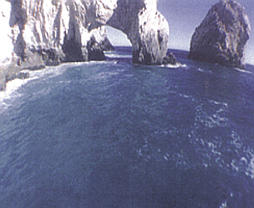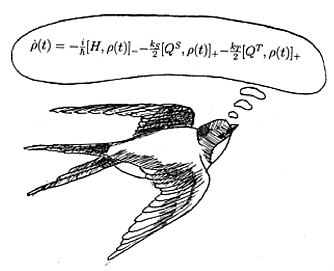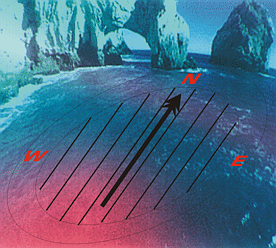The Magnetic Sense of Animals



The introductory figure summarizes our model for a photoreceptor-based magnetic compass in birds. The geomagnetic field can affect radical-pair reaction yields as governed by the stochastic Liouville equation depicted in the thinking bubble of the bird. These effects result in a modulation of visual information as shown in the right figure. The changes of visual modulation patterns with different orientations of the bird can explain the magnetic compass orientation observed in behavioral experiments.
Introduction
A large variety of animals possess a magnetic sense. Migratory birds use magnetic clues (in addition to light polarization, star signs, position of the sun) to find their way south in fall and north in spring. Salamanders, frogs, use the magnetic field for orientation when they have to find the direction of the nearest shore quickly, e.g., when they sense danger.
Behavioral experimentalists have used these natural movement patterns to design experiments that allow them to investigate in which way geomagnetic information is used for orientation. For example, during migratory unrest (Zugunruhe), birds are so eager to migrate that they will assemble even in cages in the direction they want to migrate to, e.g., south in fall. If the magnetic field is changed, so that magnetic south appears in a different direction, birds will assemble in this new direction. This behavioral assay was used in 1966 by Wolfgang Wiltschko of the University of Frankfurt, Germany to demonstrate for the first time that migratory birds indeed use magnetic clues.
Although the use of the geomagnetic field for directional information is well established experimentally, it is not known by which biophysical mechanism magnetoreception is achieved. The magnetic sense is maybe the last perception mechanism for which the nature of the receptors and of the biophysical mechanism remain unknown.
How can the geomagnetic field be perceived?
In understanding the mechanism of magnetoreception, one is immediately faced with the puzzle that the geomagnetic field is very weak (ca. 0.5 Gauss). Any suggestion for a magnetoreceptor mechanism needs to address the question whether a field as weak as the geomagnetic field can be detected by the proposed mechanism under conditions as they can be found in animals. If one thinks about how magnetic fields can be perceived in principle, three mechanisms immediately come to mind:
- Mechanical Reception - This is the principle behind a compass needle. A magnetic field exerts a torque on a ferromagnetic material or on a material with diamagnetic anisotropy. Only ferromagnets will be able to produce a response to a field as weak as 0.5 Gauss that is detectable against thermal motion. In animals, the use of small magnetic particles (e.g., magnetite) as magnetoreceptors has been suggested. The use of magnetite has been shown in magnetotactic bacteria that are rotated by a magnetic field because of the torque exerted on their magnetite particles.
- Electric Induction - Movement in a magnetic field will result in an induced electric field. Elasmobranch fish have a special sensory organ to perceive electric fields with high accuracy and can use this organ also to detect magnetic fields. However, such an organ can not be found in all animals capable of magnetoreception.
- Chemical Reception - Chemical reactions that involve transitions between different spin states can be influenced by magnetic fields, so that one of the possible products is favored due to the influence of the magnetic field. Usually, magnetic fields much stronger than the geomagnetic field are necessary to see a significant change in products. For a particular type of chemical reaction, radical-pair reactions, it has recently been shown experimentally that 0.5 Gauss magnetic fields produce a small, but measurable change in product ratios.
There are several reasons that support a chemical compass mechanism working in birds (and other higher animals, such as salamanders) rather than the other two suggestions.
- The magnetic compass in birds measures the axis but not the polarity of the magnetic field lines. In other words: the compass in birds only detects the north-south axis, but not where north and south are. Such behavior is puzzling if the receptor is indeed consisting of small magnetic particles which should provide information about the directions of north and south. There is one plausible model by Dan Edmonds in Oxford, that attempts to explain the observed response on the basis of magnetic particles as receptors.
- The magnetic compass is light-dependent. The magnetic compass in birds requires the presence of short wavelength (blue/green) light in order to work properly. If only red light is present, birds are no longer able to orient. Such behavior points to the involvement of photoreceptors rather than magnets in magnetoreception.
A Model for a Vision-Based Chemical Compass

We propose a magnetosensory organ that consists of a system of radical pairs that are orientationally ordered in the eye. We propose that a photoreceptor is part of the radical-pair system and that its sensitivity is modulated through the magnetic field effects on the radical-pair system. If one assumes an anisotropic hyperfine coupling, one can calculate in a simple radical-pair model how the response of the photoreceptor is changed depending on the angle of the magnetic field lines with the radical-pair system. Assuming that the radical-pair/photoreceptor system is distributed equally over the whole eye, one can evaluate how vision of a bird is modulated. The cartoons on top of the page illustrates how a bird converts an unprocessed image to an image which provides directional information through a radical-pair system obeying the stochastic Liouville equation. To the left, the visual modulation patterns are shown for a bird flying parallel to the horizon (geomagnetic field lines at an angle of 68 degrees with the horizon) and looking towards N,NE,E,SE,S,SW,W, and NW. The patterns are projected into the plane.
Investigators
Publications
Disrupting Magnetic Compass Orientation with Radio Frequency Oscillating Fields. Thorsten Ritz. In Proceedings of RIN01: Orientation & Navigation - Birds, Humans & other Animals. Royal Institute of Navigation, Oxford (2001).
More Interesting People and Pages
- Wolfgang and Roswitha Wiltschko [in German] - Their lab pioneered and still leads behavioral studies with migratory birds.
- John Phillips - In his lab many excellent behavioral assays for different animals have been developed
- Joseph Kirschvink - Pursues the hypothesis of magnetite particles as magnetoreceptors in different animals
- Ken Lohmann - Behavioral and neurophysiological studies of sea turtles and other marine animals
- Christiane Timmel - Studies the effects of weak static and oscillatory magnetic fields in biological contexts
- Peter Hore - Theoretical chemist, studying in particular effects of weak magnetic fields on chemical reactions



